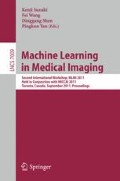Abstract
Coherent anti-Stokes Raman scattering (CARS) microscopy is attracting major scientific attention because its high-resolution, label-free properties have great potential for real time cancer diagnosis during an image-guided-therapy process. In this study, we develop a nuclear segmentation technique which is essential for the automated analysis of CARS images in differential diagnosis of lung cancer subtypes. Thus far, no existing automated approaches could effectively segment CARS images due to their low signal-to-noise ratio (SNR) and uneven background. Naturally, manual delineation of cellular structures is time-consuming, subject to individual bias, and restricts the ability to process large datasets. Herein we propose a fully automated nuclear segmentation strategy by coupling superpixel context information and an artificial neural network (ANN), which is, to the best of our knowledge, the first automated nuclear segmentation approach for CARS images. The superpixel technique for local clustering divides an image into small patches by integrating the local intensity and position information. It can accurately separate nuclear pixels even when they possess subtly lower contrast with the background. The resulting patches either correspond to cell nuclei or background. To separate cell nuclei patches from background ones, we introduce the rayburst shape descriptors, and define a superpixel context index that combines information from a given superpixel and it’s immediate neighbors, some of which are background superpixels with higher intensity. Finally we train an ANN to identify the nuclear superpixels from those corresponding to background. Experimental validation on three subtypes of lung cancers demonstrates that the proposed approach is fast, stable, and accurate for segmentation of CARS images, the first step in the clinical use of CARS for differential cancer analysis.
Access this chapter
Tax calculation will be finalised at checkout
Purchases are for personal use only
Preview
Unable to display preview. Download preview PDF.
References
Hashizume, H., Baluk, P., Morikawa, S., McLean, J.W., Thurston, G., Roberge, S., Jain, R.K., McDonald, D.M.: Openings between defective endothelial cells explain tumor vessel leakiness. Am. J. Pathol. 156, 1363–1380 (2000)
Youlden, D.R., Cramb, S.M., Baade, P.D.: The International Epidemiology of Lung Cancer: geographical distribution and secular trends. J. Thorac. Oncol. 3, 819–831 (2008)
Parkin, D.M., Bray, F., Ferlay, J., Pisani, P.: Global cancer statistics. CA Cancer J. Clin. 55, 74–108 (2005)
Diederich, S.: Lung cancer screening: status in 2007. Radiologe 48, 39–44 (2008)
Henschke, C.I., Yankelevitz, D.F., Libby, D.M., Pasmantier, M.W., Smith, J.P., Miettinen, O.S.: Survival of patients with stage I lung cancer detected on CT screening. N. Engl. J. Med. 355, 1763–1771 (2006)
McWilliams, A., MacAulay, C., Gazdar, A.F., Lam, S.: Innovative molecular and imaging approaches for the detection of lung cancer and its precursor lesions. Oncogene 21, 6949–6959 (2002)
Duncan, M.D., Reintjes, J., Manuccia, T.J.: Scanning coherent anti-Stokes Raman microscope. Optics Letters 7, 350–352 (1982)
Evans, C.L., Xie, X.S.: Coherent Anti-Stokes Raman Scattering Microscopy: Chemical Imaging for Biology and Medicine. Annu. Rev. Anal. Chem. 1, 883–909 (2008)
Cheng, J.-X., Xie, X.S.: Coherent Anti-Stokes Raman Scattering Microscopy: Instrumentation, Theory, and Applications. J. Phys. Chem. B 108, 827–840 (2004)
Evans, C.L., Potma, E.O., Xie, X.S.: Coherent anti-stokes raman scattering spectral interferometry: determination of the real and imaginary components of nonlinear susceptibility chi(3) for vibrational microscopy. Optics Letters 29, 2923–2925 (2004)
Evans, C.L., Potma, E.O., Puoris’haag, M., Cote, D., Lin, C.P., Xie, X.S.: Chemical imaging of tissue in vivo with video-rate coherent anti-Stokes Raman scattering microscopy. Proc. Natl. Acad. Sci. USA 102, 16807–16812 (2005)
Zhaozheng, Y., Bise, R., Mei, C., Kanade, T.: Cell segmentation in microscopy imagery using a bag of local Bayesian classifiers. In: 2010 IEEE International Symposium on Biomedical Imaging: From Nano to Macro, pp. 125–128 (2010)
Radhakrishna, A., Shaji, A., Smith, K., Lucchi, A., Fua, P., Susstrunk, S.: SLIC Superpixels. Technical Report 149300, EPFL (June 2010)
Lucchi, A., Smith, K., Achanta, R., Lepetit, V., Fua, P.: A fully automated approach to segmentation of irregularly shaped cellular structures in EM images. In: Jiang, T., Navab, N., Pluim, J.P.W., Viergever, M.A. (eds.) MICCAI 2010. LNCS, vol. 6362, pp. 463–471. Springer, Heidelberg (2010)
Author information
Authors and Affiliations
Editor information
Editors and Affiliations
Rights and permissions
Copyright information
© 2011 Springer-Verlag Berlin Heidelberg
About this paper
Cite this paper
Hammoudi, A.A. et al. (2011). Automated Nuclear Segmentation of Coherent Anti-Stokes Raman Scattering Microscopy Images by Coupling Superpixel Context Information with Artificial Neural Networks. In: Suzuki, K., Wang, F., Shen, D., Yan, P. (eds) Machine Learning in Medical Imaging. MLMI 2011. Lecture Notes in Computer Science, vol 7009. Springer, Berlin, Heidelberg. https://doi.org/10.1007/978-3-642-24319-6_39
Download citation
DOI: https://doi.org/10.1007/978-3-642-24319-6_39
Publisher Name: Springer, Berlin, Heidelberg
Print ISBN: 978-3-642-24318-9
Online ISBN: 978-3-642-24319-6
eBook Packages: Computer ScienceComputer Science (R0)

